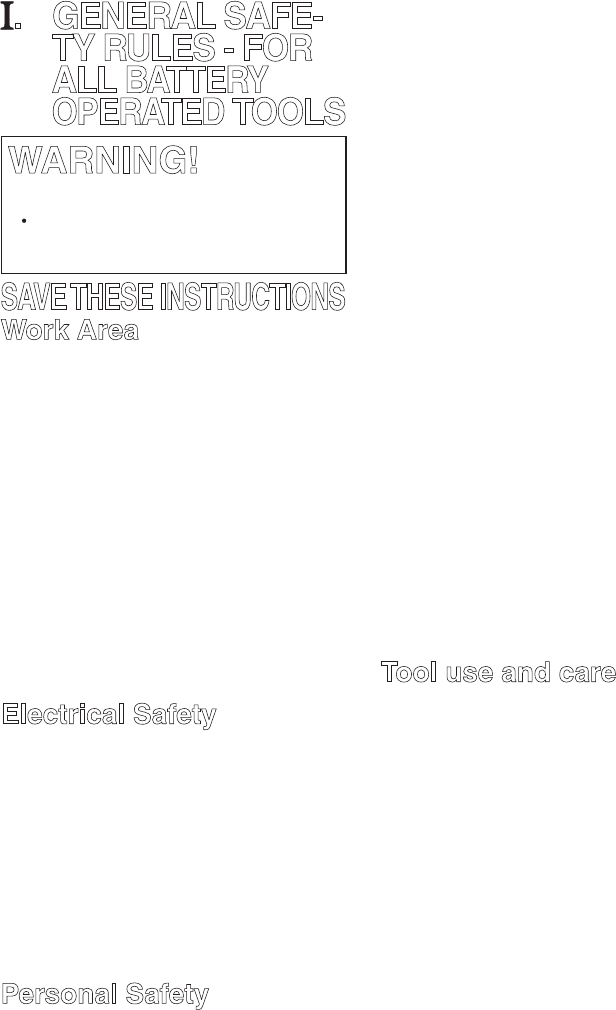
-
2
-
-
3
-
. GENERAL SAFE-
TY RULES - FOR
ALL
BATTERY
OPERATED
TOOLS
WARNING!
READ AND UNDERSTAND ALL INSTRUCTIONS.
Failure to follow all instructions listed
below, may result in electric shock,
fire and/or serious personal injury.
SAVE THESE INSTRUCTIONS
Work Area
1) Keep your work area clean and well
lit.
Cluttered benches and dark areas
invite accidents.
2) Do not operate power tools in
explosive atmospheres, such as
in the presence of flammable liq-
uids, gases, or dust.
Power tools create sparks which may
ignite the dust or fumes.
3) Keep bystanders, children, and vis-
itors away while operating a power
tool.
Distractions can cause you to lose
control. Make sure that no one is
beneath, or on the other side of the
area when you are working.
Electrical Safety
4) A battery operated tool with integral
batteries or a separate battery pack
must be recharged only with the
specified charger for the battery.
A charger that may be suitable for one
type of battery may create a risk of fire
when used with another battery.
5) Use battery operated tool only
with specifically designated bat-
tery pack.
Use of any other batteries may cre-
ate a risk of fire.
Personal Safety
6) Stay alert, watch what you are
doing, and use common sense
when operating a power tool. Do
not use tool while tired or under
the influence of drugs, alcohol, or
medication.
A moment of inattention while operat-
ing power tools may result in serious
personal injury.
7) Dress properly. Do not wear loose
clothing or jewelry. Contain long hair.
Keep your hair, clothing, and
gloves away from moving parts.
Loose clothes, jewelry, or long hair
can be caught in moving parts.
8) Avoid accidental starting. Be sure
switch is in the locked or off posi-
tion before inserting battery pack.
Carrying tools with your finger on the
switch or inserting the battery pack
into a tool with the switch on invites
accidents.
9)
Remove adjusting keys or wrenches
before turning the tool on.
A wrench or a key that is left attached
to a rotating part of the tool may
result in personal injury.
10) Do not overreach. Keep proper
footing and balance at all times.
Proper footing and balance enable
better control of the tool in unexpect-
ed situations.
11) Use safety equipment. Always wear
eye protection.
Dust mask, non-skid safety shoes,
hard hat, or hearing protection must
be used for appropriate conditions.
Tool use and care
12) Use clamps or other practical way
to secure and support the work-
piece to a stable platform.
Holding the work by hand or against
your body is unstable and may lead
to loss of control.
13) Do not force tool. Use the correct
tool for your application.
The correct tool will do the job better
and safer at the rate for which it is
designed.
14) Do not use tool if switch does not
turn it on or off.
A tool that cannot be controlled with
the switch is dangerous and must be
repaired.
15)
Disconnect battery pack from tool or
place the switch in the locked or off
position before making any adjust-
ments, changing accessories, or stor-














